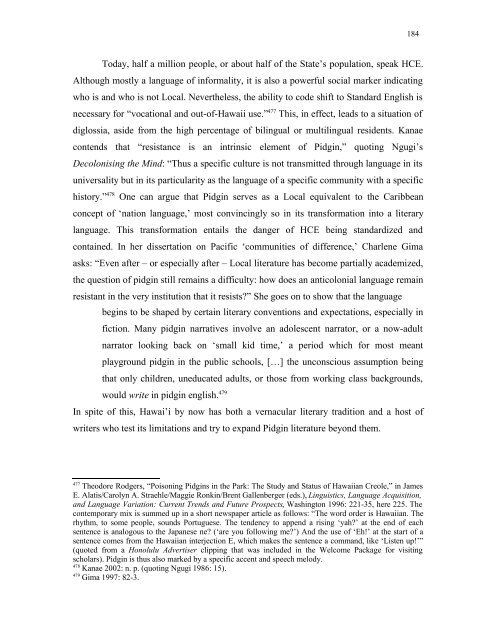A Paradise Lost - KOPS - Universität Konstanz
A Paradise Lost - KOPS - Universität Konstanz
A Paradise Lost - KOPS - Universität Konstanz
You also want an ePaper? Increase the reach of your titles
YUMPU automatically turns print PDFs into web optimized ePapers that Google loves.
Today, half a million people, or about half of the State’s population, speak HCE.<br />
Although mostly a language of informality, it is also a powerful social marker indicating<br />
who is and who is not Local. Nevertheless, the ability to code shift to Standard English is<br />
necessary for “vocational and out-of-Hawaii use.” 477 This, in effect, leads to a situation of<br />
diglossia, aside from the high percentage of bilingual or multilingual residents. Kanae<br />
contends that “resistance is an intrinsic element of Pidgin,” quoting Ngugi’s<br />
Decolonising the Mind: “Thus a specific culture is not transmitted through language in its<br />
universality but in its particularity as the language of a specific community with a specific<br />
history.” 478 One can argue that Pidgin serves as a Local equivalent to the Caribbean<br />
concept of ‘nation language,’ most convincingly so in its transformation into a literary<br />
language. This transformation entails the danger of HCE being standardized and<br />
contained. In her dissertation on Pacific ‘communities of difference,’ Charlene Gima<br />
asks: “Even after – or especially after – Local literature has become partially academized,<br />
the question of pidgin still remains a difficulty: how does an anticolonial language remain<br />
resistant in the very institution that it resists?” She goes on to show that the language<br />
begins to be shaped by certain literary conventions and expectations, especially in<br />
fiction. Many pidgin narratives involve an adolescent narrator, or a now-adult<br />
narrator looking back on ‘small kid time,’ a period which for most meant<br />
playground pidgin in the public schools, […] the unconscious assumption being<br />
that only children, uneducated adults, or those from working class backgrounds,<br />
would write in pidgin english. 479<br />
In spite of this, Hawai’i by now has both a vernacular literary tradition and a host of<br />
writers who test its limitations and try to expand Pidgin literature beyond them.<br />
477 Theodore Rodgers, “Poisoning Pidgins in the Park: The Study and Status of Hawaiian Creole,” in James<br />
E. Alatis/Carolyn A. Straehle/Maggie Ronkin/Brent Gallenberger (eds.), Linguistics, Language Acquisition,<br />
and Language Variation: Current Trends and Future Prospects, Washington 1996: 221-35, here 225. The<br />
contemporary mix is summed up in a short newspaper article as follows: “The word order is Hawaiian. The<br />
rhythm, to some people, sounds Portuguese. The tendency to append a rising ‘yah?’ at the end of each<br />
sentence is analogous to the Japanese ne? (‘are you following me?’) And the use of ‘Eh!’ at the start of a<br />
sentence comes from the Hawaiian interjection E, which makes the sentence a command, like ‘Listen up!’”<br />
(quoted from a Honolulu Advertiser clipping that was included in the Welcome Package for visiting<br />
scholars). Pidgin is thus also marked by a specific accent and speech melody.<br />
478 Kanae 2002: n. p. (quoting Ngugi 1986: 15).<br />
479 Gima 1997: 82-3.<br />
184

















